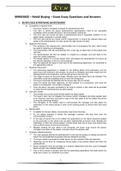MNM3602 – Retail Buying – Exam Essay Questions and Answers
1. BUYER’S ROLE IN PREPARING ADVERTISEMENT
a. Complete a request form
The buyer needs to complete a request for advertisement form.
This form is where the actual advertisement specifications need to be accurately
completed, which include the layout, size and product, pricing etc.
This form also will include the type of advertisement that is requested, whether it is for
digital media, broadcast or printed media.
This form also serves as a stock control measurement, to ensure the relevant stores are
aware of the advertisement, but also carries the right amount of stock
b. Approve the layout
The sending of the request form, merchandise has to accompany the form, which could
be used for sketching or photography.
The merchandise with will accompanied with a loan tag, to keep trace of the product and
returned.
The advertisement will then be drafted, or created as a sample, and sent back to the
buyer for careful inspection.
The design agency or in-house design team will prepare the advertisement to ensure all
the relevant requests on the form are processed.
After the approval the layout is then sent to the advertising department, for transmittal to
the appropriate medium.
c. Examine the proof
The advertising department is reliable for the drafting before final submission, but the
buyer has to be involved in the process, to ensure no mistakes have been made from the
drawing board to the production, and everything has to be error free.
This stage is known as the proof stage, whereby every last detail has to be checked. The
information could have spelling errors or even the wrong price.
The layout could also be affected with the wrong copy next to a photo.
Once the advert has been approved, its then passed on to production, and once the
advert is in production, it's too late to change it.
Once the advert has been scheduled to be aired or printed, a tear sheet will be provided
as proof that the advertisement has been placed.
d. Use tear sheets
Tear sheets are not only proof that the advert has been placed.
The buyer's work has not stopped, the various outlets' managers and sales people need
to be informed, and they must send a copy of the tear sheet to all the outlets that will be
running the advertised product.
The managers of the outlets need to communicate the message and also place the
notification on the notice boards or even at the clocking points to ensure they have read
them.
e. Notify Staff
In addition to the tear sheets, the branches need to be informed.
It's not always practical to deliver the message in-person, and they have sent the
communication to them.
In the case of branch that is not notified, the expenditure on the advert would be wasted
as the promotion of the advert has not been implemented at branch level. Besides the
notification of staff, the communication of stock levels also has to occur and ensure they
have sufficient stock at hand at all branches.
Besides sending the tear sheet to the branches, the buyer must ensure the branch
managers are aware of this advert, and also inform the relevant staff.
f. Evaluate advertisements
The main purpose behind the advertisement is see that the product is selling and that the
advert has accomplished its purpose and was designed correctly.
The buyer needs to evaluate the sales figures to have sufficient data and reporting.
Reporting can be done by comparing normal sales of the product before and after the
advertisement.
Some companies have the privilege of a research department and they could investigate
better and get more detailed feedback.
This is all to ensure a success and that the advertising expenditure has been worth the
while and a return on investment is at hand.
1
, 2. REASONS TO BUY FOREIGN MERCHANDISE
a. Lower cost
Raw material pricing higher in own country
Labour in factories much lower in other countries
Variety is greater at a lower costs
b. Quality
Natural resources is lower in the manufacturing country
Craftsmanship is better in other countries
Hourly rate of labour too expensive in own country
c. Greater profit
Efficient purchases contribute towards greater profits
Higher mark-ups occur on lower cost imports
Exclusivity on product ranges, higher profits on items
d. Prestige
People tend to get drawn to exclusive imported brands
Exclusive designer brands in fashion
Limited quantities contribute towards prestige
e. Unavailability of merchandise in country
Certain products are not produced in own country
Duplication of these products would make the costs too high.
Imitations are not same quality, people tend to import rather.
3. PROBLEMS BUYING FOREIGN MERCHANDISE
a. Delivery
Guaranteed delivery cannot be obtained, especially with strikes from
truck drivers.
b. Quality variations
Buying from foreign suppliers, could have quality variations from the
initial order.
Returns could be expensive and damage could harm the retailer if stock
is not available.
c. Reorders
Buyer success is based on selected merchandise that could be ordered
again and again.
Lead time to deliver can’t be guaranteed, unless if staple product which
could be order in bulk ahead.
Seasonal or fashion products carries the risk on reorders.
d. Early selection of colours
Fashion buyers must select colours in advance, and could get help from
fashion services or market specialists.
Problem persists that the specialists can’t supply correct info on colours
before order must be placed.
e. Size discrepancies
Every country has different sizes, even though they compare to a size
chart.
USA is bigger in sizes, and Far East is smaller.
f. Money allocation
Some buyers negotiate terms on payment, but buying abroad, they have
insisted on partial payment.
Problem arises when then the shipment could take up to a year, and
capital is then tied up in the orders.
2





